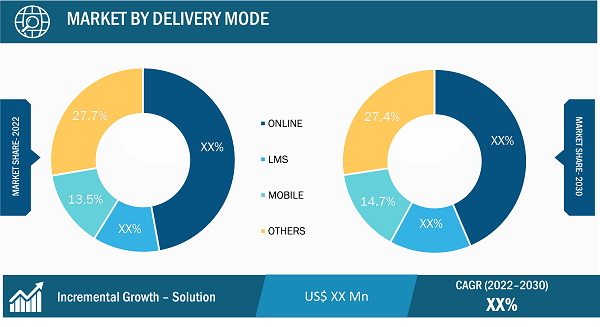Ease of Tracking Student Performance and Maintaining a Centralized Student Database Boosts E-Learning Market Growth
According to our latest study on “MENA E-Learning Market Forecast to 2030 – Market Size and Forecasts (2020–2030), Global and Regional Share, Trends, and Growth Opportunity Analysis Report Coverage – by Delivery Mode, Learning Mode, and End User,” the MENA E-Learning market size was valued at US$ 13.60 billion in 2022 and is expected to reach US$ 35.76 billion by 2030. The MENA E-Learning market is expected to record a CAGR of 12.8% from 2022 to 2030.
E-learning enables teachers to track the progress of students and to make sure their performance accomplishments are met. To ensure that educational activities are fulfilling the ultimate purpose of education and proceeding in the right direction, an institution must track students’ progress. The student performance’s impact is the focus of online learning since it can determine higher education institutions to get public trust and good ratings and the success of students. In the MENA, educational institutes are pursuing new methods for handling student data better and optimizing their operations. Student database management systems reduce workforce requirements, make their tasks easier, and ensure effective learning processes. The educational institutions are also maintaining a centralized student database to assemble student information such as progress reports, medical history, exam results, and attendance records at a centralized location.
Middel East and Africa E-Learning Market – By Delivery Mode, 2022 and 2030
MENA E-Learning Market Size and Forecasts (2020 - 2030), Regional Share, Trends, and Growth Opportunity Analysis Report Coverage: By Delivery Mode (Online, LMS, Mobile, and Others); Learning Mode (Instructor Led and Self-Paced), and End User (Academic and Corporate)
MENA E-Learning Market Growth Report and Size by 2030
Download Free Sample
Source: The Insight Partners Analysis
To streamline the process of managing student data, a lot of educational institutions are investing in a high-performance student database management system. The cloud or web-based software helps institutes store and organize student-related data in a centralized database. The centralized student database management system automates the process of data handling, thus saving a great deal of time. It also minimizes the chances of human error. A student database management system facilitates smooth communication between parents and teachers, students and teachers, and among students. With a centralized student database, teachers can notify parents about important school events, such as parent-teacher meetings and sports day/annual day celebrations instantaneously. It also enables teachers to send instant updates to parents about their ward's attendance, performance reports, disciplinary problems, students’ bus boarding, school bus arrival, and much more over SMS or email. To track the performance of the students and maintain a centralized database, various institutes and organizations are using the software. For example, Nigerian ed-tech startup Insight Africa has been using its Studylab product since 2019 to allow teachers and schools to monitor the progress of their students across each subject while providing video tutorials to help fill gaps. Thus, e-learning platforms foster the ease of tracking student performances and maintaining a centralized database, boosting their popularity among education stakeholders in the MENA, thereby driving e-learning market growth.
The Middle East's old educational systems are changing as a result of technological improvements, as they adjust to new tools, methodologies, and teaching strategies. In order to continue uninterrupted education throughout the COVID-19 epidemic, remote and hybrid learning methods were widespread. These arrangements are now viewed as the educational model of the future boosting the E-learning market.
The COVID-19 pandemic has prevented more than 103 million pupils in the MENA region from going to school, according to the World Bank. This has prompted the introduction of many market players offering online solutions in the region’s E-learning market. For instance, according to the 2022 study led by Coursera, in MENA, only around a third (31%) of those questioned took online courses up until November 2022, and 95% of them are 'open' to doing so in 2023, with 68% of them being very receptive. This has managed to develop an environment for the proliferation of various solutions in the MENA e-learning market.
The MENA E-Learning market is categorized on the basis of delivery mode, learning mode, and end user. Based on delivery mode, the E-Learning market is segmented into online, LMS, mobile, and others. By learning mode, the E-Learning market is segmented into instructor-led, self-paced. Based on end user, the E-Learning market is categorized into academics and corporate. The MENA E-Learning market, based on country, is categorized into the UAE, Saudi Arabia, Egypt, Jordan, and Qatar.
Adobe Inc., Citrix Systems Inc., Coursera Inc., Oracle Corp, SAP SE, Udemy Inc., Little Thinking Minds CO LLCc, Synkers FZ-LLC, Lamsa FZ LLC, And Udacity Inc. are among the key players operating in the MENA market.
Contact Us
Phone: +1-646-491-9876
Email Id: sales@theinsightpartners.com